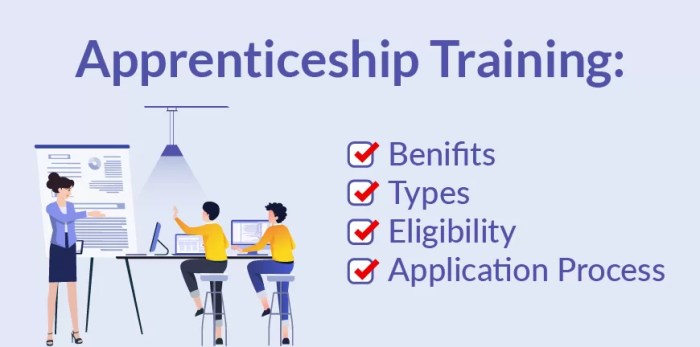
What is an apprenticeship? It’s a powerful blend of on-the-job training and structured learning, offering a unique pathway to a skilled career. This in-depth look explores the various facets of apprenticeships, from their historical roots to the modern-day benefits and challenges.
Apprenticeships combine practical experience with formal instruction, often leading to valuable certifications and in-demand skills. They provide a hands-on approach to learning, enabling apprentices to gain real-world expertise while simultaneously earning income. This contrasts with traditional academic programs, which often focus primarily on theoretical knowledge. The program structure typically involves a combination of classroom learning, mentorship, and on-the-job training, leading to a well-rounded skillset.
Defining Apprenticeship

Apprenticeships are a powerful pathway to skilled trades and professional careers. They combine structured on-the-job training with classroom learning, providing a unique blend of practical experience and theoretical knowledge. This hands-on approach is a cornerstone of many successful careers, fostering a deep understanding of a specific field.Apprenticeships are more than just a training program; they are a valuable investment in both the individual and the economy.
They provide a structured and often guaranteed path to employment for those seeking specialized skills, and often result in high-skilled, productive employees for businesses.
Apprenticeship Definition
An apprenticeship is a work-based learning program that integrates on-the-job training with structured classroom instruction. This combination of practical experience and theoretical knowledge prepares individuals for specific trades, professions, or occupations. Apprenticeships typically have clearly defined learning objectives, competency standards, and assessment procedures. They are designed to equip individuals with the knowledge and skills necessary to perform specific tasks within a particular industry or profession.
Historical Context and Evolution
Apprenticeships have a long and rich history, evolving from medieval guilds to modern vocational training programs. Early forms of apprenticeship were often characterized by a master-apprentice relationship, where a skilled artisan mentored a younger individual. Over time, the structure and regulations of apprenticeships have evolved, adapting to changing economic needs and technological advancements. Today, many apprenticeships are governed by formal standards and regulations, ensuring quality and consistency.
Types of Apprenticeships
Apprenticeships cater to a wide range of career paths, encompassing both vocational and academic fields. Vocational apprenticeships focus on practical skills and technical expertise, such as carpentry, plumbing, or electrical work. Academic apprenticeships often blend technical skills with theoretical knowledge from a university or college setting, and may be more closely aligned with specific professions like engineering or design.
Apprenticeships vs. Other Training Programs
Apprenticeships differ from other training programs, such as vocational courses or internships. While vocational courses might focus on specific technical skills, apprenticeships are typically work-based and integrated into an employer’s operations. Internships, often focused on gaining practical experience within a specific field, often lack the structured learning components and formalized qualifications of apprenticeships. Apprenticeships, in contrast, have clear learning objectives and assessments to ensure competency.
Apprenticeships vs. Internships
A key difference between apprenticeships and internships lies in the level of structured learning and formal recognition. Apprenticeships typically involve a structured curriculum, assessment procedures, and formalized qualifications. Internships, while valuable for practical experience, often lack these formalized components. An apprenticeship is usually a step toward a recognized professional qualification, whereas an internship is often more focused on gaining experience within a specific field.
Common Elements of Different Apprenticeship Types
The table below highlights common elements across various apprenticeship types. This illustrates the consistent structure and quality assurance mechanisms that underpin apprenticeship programs.
| Element | Vocational Apprenticeship | Academic Apprenticeship |
|---|---|---|
| Learning Method | On-the-job training combined with classroom instruction | On-the-job training combined with classroom instruction and academic coursework |
| Duration | Typically 2-5 years | Typically 2-5 years, sometimes longer depending on academic requirements |
| Assessment | Regular evaluations by employers and assessors | Regular evaluations by employers, assessors, and academic institutions |
| Certification | Industry-recognized certifications | Industry-recognized certifications and academic credentials |
Benefits of Apprenticeships: What Is An Apprenticeship

Apprenticeships offer a unique pathway to gain practical skills and valuable experience while earning a wage. This dual learning model provides a tangible advantage for both the apprentice and the employer, fostering a symbiotic relationship that benefits the entire community. This approach bridges the gap between theoretical knowledge and real-world application, preparing individuals for successful careers and boosting the economy.Apprenticeships are a powerful tool for skill development, providing a hands-on learning experience that is increasingly recognized as crucial for a competitive workforce.
The blend of classroom instruction and practical application makes apprenticeships particularly attractive to both employers seeking skilled employees and individuals eager to learn and advance their careers.
Advantages for Apprentices, What is an apprenticeship
Apprenticeships provide a structured learning environment with clear career pathways. This structured approach gives apprentices a significant advantage in the job market, offering them a clear path to success.
- Financial Benefits: Apprenticeships typically involve a combination of on-the-job training and structured learning, enabling apprentices to earn a salary while acquiring valuable skills. This dual income stream provides a stable financial foundation, allowing apprentices to gain practical experience and accumulate savings during their training. For example, a recent study by the National Apprenticeship Service showed that apprentices typically earn more over their careers than those who did not participate in apprenticeship programs.
Apprenticeships are a fantastic way to gain practical skills and real-world experience while earning a wage. But, how do you track your progress and ensure you’re hitting your goals? Understanding how to measure key performance indicators (KPIs) is crucial for success in any role, including apprenticeships. For a deep dive into the specifics of KPI measurement, check out this helpful guide on how to measure KPIs.
Ultimately, a successful apprenticeship hinges on consistent effort and understanding how to effectively monitor your performance against key targets.
- Career Advancement: Apprenticeships offer a direct route to a specific career, often leading to specialized certifications or qualifications. These pathways can lead to promotions, higher earning potential, and long-term job security. The structured nature of apprenticeships helps apprentices to build a solid foundation for future career growth, and successful apprentices are frequently sought after by employers.
- Personal Growth: Apprenticeships provide a practical and immersive learning environment that fosters the development of valuable personal attributes such as time management, problem-solving, and teamwork. These transferable skills are highly sought after by employers and contribute to overall personal and professional development.
Advantages for Employers
Apprenticeships are a cost-effective way to develop skilled employees, addressing a critical need for trained professionals in various industries.
- Reduced Recruitment Costs: Apprenticeships offer a built-in talent pipeline, reducing the need for expensive recruitment campaigns and hiring processes. This cost-effectiveness is significant, particularly for companies facing shortages of skilled workers.
- Increased Productivity: Apprenticeships provide a ready source of trained employees, allowing companies to avoid the initial training costs and time associated with onboarding new employees. Apprentices quickly become productive members of the workforce, contributing to increased output and efficiency.
- Enhanced Employee Loyalty: Apprenticeships provide a pathway for employees to advance their careers within the company. This structured progression fosters employee loyalty and reduces turnover, resulting in long-term cost savings for the employer.
Benefits to the Community and Economy
Apprenticeships contribute to a stronger and more skilled workforce, ultimately benefiting the entire community and the national economy.
- Improved Workforce Skills: Apprenticeships provide a focused approach to skill development, equipping individuals with the necessary knowledge and abilities to thrive in the modern economy. This ensures a more skilled and adaptable workforce.
- Economic Growth: Apprenticeships are directly linked to economic growth. A skilled workforce leads to increased productivity, innovation, and competitiveness, ultimately boosting the overall economy. For example, many sectors, such as construction and manufacturing, have seen significant economic growth by incorporating apprenticeship programs.
- Social Mobility: Apprenticeships can provide pathways to employment for individuals from diverse backgrounds, offering a chance for social mobility and economic empowerment. This is particularly crucial in promoting inclusivity and opportunity within the workforce.
Skills and Knowledge Acquired
Apprenticeships provide a unique combination of theoretical knowledge and practical application. This approach is instrumental in developing a well-rounded skill set.
Apprenticeships are a fantastic way to gain practical skills and experience, often alongside formal qualifications. They’re a win-win, really. But in today’s remote-first world, strong employer branding for remote companies is crucial for attracting and retaining the best talent. Employer branding for remote companies needs to showcase the perks and flexibility that remote work offers.
Ultimately, a well-structured apprenticeship program is a great way to build a strong team, and ensure a pipeline of skilled workers for the future.
- Technical Skills: Apprenticeships provide hands-on training in a specific trade or profession, enabling apprentices to develop specialized technical skills. These skills are crucial for performing tasks and contributing effectively to their chosen field.
- Soft Skills: Apprenticeships nurture soft skills such as communication, teamwork, problem-solving, and time management. These skills are essential for success in any professional environment.
Examples of Successful Apprenticeship Programs
Numerous successful apprenticeship programs exist across various sectors, showcasing the effectiveness of this learning model.
- Construction Apprenticeships: Construction apprenticeships provide comprehensive training in carpentry, plumbing, and electrical work, preparing individuals for careers in the construction industry. This is a sector with a high demand for skilled workers.
- Manufacturing Apprenticeships: Manufacturing apprenticeships provide training in areas such as machining, welding, and metalworking, equipping individuals with the skills to excel in the manufacturing sector. This is a significant industry that directly contributes to the economy.
Specific Skills and Knowledge Developed in Different Apprenticeships
| Apprenticeship Type | Specific Skills Developed | Knowledge Acquired |
|---|---|---|
| Construction | Carpentry, plumbing, electrical work | Building codes, safety regulations, material handling |
| Manufacturing | Machining, welding, metalworking | Machine operation, quality control, manufacturing processes |
| Information Technology | Coding, software development, database management | Software engineering principles, data security, cloud computing |
Structure and Components of an Apprenticeship
Apprenticeships offer a unique blend of practical experience and theoretical learning, providing a pathway to valuable skills and qualifications. Understanding the structure and components of an apprenticeship program is crucial for both aspiring apprentices and employers. This section delves into the typical program design, roles, and responsibilities, and the essential elements of a successful apprenticeship.Apprenticeship programs are meticulously structured to ensure a balanced approach to skill development.
This structure usually involves a combination of on-the-job training and structured learning, culminating in a recognized qualification. The program is designed to equip apprentices with the technical expertise and practical knowledge necessary for their chosen field.
Typical Structure of an Apprenticeship Program
Apprenticeship programs typically follow a structured format, combining classroom learning with hands-on experience. Training phases are often staggered, progressively increasing the apprentice’s responsibility and complexity of tasks.
- Initial Training Phase: This phase often involves foundational knowledge and basic skills training in a classroom or workshop setting. It provides a strong theoretical base for the apprentice to build upon.
- On-the-Job Training Phase: This is a critical component, allowing the apprentice to apply learned skills in a real-world environment under the guidance of a qualified mentor or supervisor. This phase emphasizes practical application and problem-solving.
- Advanced Training and Project Work: As the apprentice progresses, the training may involve more complex tasks, projects, and potentially specialized training tailored to specific roles within the industry.
Evaluation Processes in Apprenticeships
Regular evaluation is crucial to monitor the apprentice’s progress and ensure they meet the required standards.
- Regular Assessments: These can include practical demonstrations, written tests, presentations, and portfolios, providing a comprehensive assessment of the apprentice’s knowledge and abilities.
- Performance Reviews: Employers conduct regular reviews of the apprentice’s performance, providing feedback and guidance to improve their skills and knowledge.
- Supervisory Support: Mentorship and guidance from experienced professionals are vital components of the evaluation process. They provide feedback and support throughout the apprenticeship.
Roles and Responsibilities of Apprentices and Employers
A successful apprenticeship hinges on clear roles and responsibilities.
- Apprentices’ Responsibilities: Apprentices are expected to actively participate in training, diligently complete assigned tasks, and demonstrate a willingness to learn and improve their skills. This includes attending training sessions, completing coursework, and consistently applying learned skills on the job.
- Employers’ Responsibilities: Employers are responsible for providing a supportive learning environment, providing adequate supervision and mentorship, and ensuring the apprentice receives the necessary training and development opportunities. They also need to create a safe and structured work environment where apprentices can thrive.
Required Qualifications for Apprentices and Employers
Specific requirements vary depending on the trade or profession, but generally, apprentices must possess a certain level of commitment, aptitude, and enthusiasm for the trade.
- Apprentice Qualifications: Apprentices typically need a high school diploma or equivalent, a demonstrated interest in the chosen trade, and a commitment to the apprenticeship program’s duration.
- Employer Qualifications: Employers should have a commitment to training and development, possess the necessary resources and expertise to guide the apprentice, and have a clear understanding of the apprenticeship standards.
Common Elements of Apprenticeship Agreements
A formal agreement Artikels the terms and conditions of the apprenticeship.
- Training Schedule: A detailed timetable outlining the training phases, including classroom time and on-the-job experience, is critical.
- Compensation and Benefits: The agreement should clearly define the compensation structure, including wages, and any associated benefits.
- Evaluation Procedures: A clear process for evaluating the apprentice’s progress and performance is essential for both parties.
Steps Involved in Starting an Apprenticeship
The process for initiating an apprenticeship involves several steps.
| Step | Description |
|---|---|
| 1 | Identify a suitable apprenticeship program and employer |
| 2 | Complete the necessary application and assessment process |
| 3 | Sign the apprenticeship agreement |
| 4 | Begin the structured training and on-the-job experience |
| 5 | Regularly meet with the supervisor for feedback and progress evaluation |
Learning Outcomes of Apprenticeships vs. Traditional Education
Apprenticeships provide a practical learning approach, contrasting with the more theoretical focus of traditional education.
| Feature | Apprenticeship | Traditional Education |
|---|---|---|
| Focus | Practical application and hands-on experience | Theoretical knowledge and academic study |
| Assessment | Performance-based evaluations, practical demonstrations | Tests, exams, and coursework |
| Learning Pace | Adaptive to individual needs and progress | Standardized curriculum and pace |
| Career Path | Directly focused on a specific industry and skillset | Broader knowledge base, potential for multiple career paths |
Finding and Securing an Apprenticeship
Landing an apprenticeship requires more than just applying—it demands a strategic approach. This involves meticulous research, a compelling application, and a confident interview performance. Understanding the available resources, crafting a strong resume and cover letter, and mastering interview techniques are crucial steps to success.A well-planned apprenticeship search involves proactive exploration of opportunities and careful preparation for each stage of the application process.
An apprenticeship is essentially a hands-on learning experience, combining classroom instruction with practical work. Imagine gaining real-world skills alongside experienced professionals. This learning style is increasingly relevant in today’s fast-paced world, and advancements in technology like the “brain scanning bot maps minds at warp speed” brain scanning bot maps minds at warp speed highlight the growing need for practical skills.
Ultimately, an apprenticeship is a great way to launch a career while gaining invaluable experience.
This meticulous approach, coupled with a proactive attitude, significantly increases the likelihood of securing a suitable apprenticeship.
Resources for Finding Apprenticeship Opportunities
Various resources are available to help locate apprenticeship programs. These resources range from dedicated online portals to career centers and industry-specific platforms.
- Government websites often host comprehensive apprenticeship registries, providing a centralized database of available positions. These registries are excellent starting points for identifying suitable opportunities based on your desired field and location.
- Company websites and career pages are valuable resources for finding in-house apprenticeship programs. Many companies proactively list their apprenticeship programs on their career pages, providing a direct avenue to explore opportunities within a specific organization.
- Industry associations and professional organizations frequently list apprenticeships relevant to their sectors. Networking with professionals within your desired field can also uncover hidden opportunities.
- Dedicated apprenticeship platforms and job boards are specifically designed to connect apprentices with employers. These platforms often provide a more focused search, helping you filter opportunities by industry, location, and specific skills.
Developing a Strong Resume and Cover Letter
A well-crafted resume and cover letter are essential for making a positive first impression. Tailoring these documents to each apprenticeship application demonstrates your genuine interest and understanding of the role.
- Highlight relevant skills and experiences. Emphasize achievements and quantifiable results to showcase your competency. Use action verbs and strong language to describe your contributions.
- Showcase transferable skills. Skills developed in previous roles, such as teamwork, communication, or problem-solving, are often highly valued in apprenticeship programs.
- Tailor your resume and cover letter to each application. This demonstrates that you’ve done your research and understand the specific requirements of the apprenticeship.
- Proofread carefully for any errors in grammar or spelling. A professional and error-free application enhances your credibility and professionalism.
Interview Questions and Answers
Preparing for interview questions specific to apprenticeships is crucial for demonstrating your suitability. Practicing responses to common questions can help you confidently address concerns and highlight your skills.
- “Why are you interested in this apprenticeship?” Showcase your genuine interest by highlighting specific aspects of the program or company that resonate with you. Explain how your skills and aspirations align with the apprenticeship’s objectives.
- “What are your strengths and weaknesses?” Identify your strongest skills and how they relate to the apprenticeship requirements. For weaknesses, acknowledge a specific area where you are working to improve, and provide examples of how you are developing those skills.
- “Tell me about a time you faced a challenge and how you overcame it.” Choose a relevant experience where you faced a challenge and successfully resolved it. Detail the steps you took, the outcomes, and the lessons learned.
- “What are your career goals?” Clearly articulate your long-term career aspirations and how the apprenticeship fits into your overall plan. Demonstrate a clear understanding of the apprenticeship’s contribution to your future goals.
Applying for an Apprenticeship and the Selection Process
Understanding the application process and the selection criteria can help you strategically navigate the process.
- Review the application requirements thoroughly before starting. Ensure you meet all the specified criteria and gather all necessary documents.
- Complete the application forms accurately and completely. Pay attention to detail and double-check all information.
- Submit your application by the deadline. Late submissions may be overlooked.
- The selection process often involves an initial screening, followed by interviews and potentially further assessments. Be prepared for each stage and demonstrate your qualifications throughout.
Common Documents Required for Apprenticeship Applications
The necessary documents for apprenticeship applications vary depending on the program. Understanding the specific requirements is crucial for a smooth application process.
- Resume
- Cover letter
- Transcript of records
- References
- Identity documents
Comparing Apprenticeship Application Portals
Different platforms offer varying features and services. This comparison table helps you evaluate the best platform for your needs.
| Portal | Pros | Cons |
|---|---|---|
| Apprenticeship.gov | Centralized, comprehensive database; government-backed. | Limited job types; may require additional searching. |
| Indeed.com | Wide range of job listings, including apprenticeships. | May not be as focused on apprenticeships as specialized portals. |
| Company Career Pages | Direct access to in-house opportunities. | Limited to companies with active apprenticeship programs. |
Apprenticeship in Different Industries
Apprenticeships are not confined to a single sector; they are a versatile pathway to skilled employment, adaptable to various industries. From traditional trades to emerging technological fields, apprenticeships offer a structured learning environment that bridges the gap between theoretical knowledge and practical application. This adaptability is key to their continued relevance and success.Apprenticeships have proven themselves to be a highly effective way to train and develop skilled workers in a variety of fields, while simultaneously addressing the needs of businesses for qualified personnel.
Their adaptability to changing industry demands is crucial for ensuring they remain a valuable tool for both individuals and employers.
Prevalence of Apprenticeships Across Industries
Apprenticeship programs are prevalent across numerous industries, catering to diverse skill sets and career aspirations. From the trades and construction to technology and healthcare, apprenticeships provide a practical approach to learning. Their adaptability makes them a valuable tool for both individuals and employers, ensuring that they remain relevant in an ever-evolving job market.
Examples of Specific Apprenticeship Programs
Numerous specific apprenticeship programs exist within different industries, each tailored to the unique demands of the field. For instance, the automotive industry offers apprenticeships in areas like mechanics, technicians, and manufacturing. Likewise, the healthcare sector has apprenticeships for nursing assistants, medical assistants, and pharmacy technicians. This demonstrates the breadth of applicability for apprenticeships.
Adapting to Emerging Technologies and Industry Needs
Apprenticeships are dynamic; they adapt to emerging technologies and industry needs. Programs in the digital technology sector, for example, are constantly evolving to keep pace with advancements in software development, cybersecurity, and data science. This responsiveness ensures that apprentices gain relevant skills that are in demand in the modern workforce. This adaptability allows for ongoing development and relevance.
Future of Apprenticeships in Specific Industries
The future of apprenticeships in various industries is bright. In the renewable energy sector, for example, apprenticeships are likely to play an increasingly significant role in training the workforce needed for the transition to sustainable energy sources. Similarly, the growing demand for skilled professionals in the healthcare sector will continue to support a robust apprenticeship system. This future-oriented perspective ensures that apprenticeships remain relevant to the needs of industry.
Specialization Through Apprenticeships
Apprenticeships can lead to specialization within a chosen field. For instance, a mechanical engineering apprentice can further specialize in areas like robotics, automation, or aerospace engineering. Similarly, a healthcare apprentice can specialize in specific medical disciplines. This structured learning environment fosters specialization within a broad field.
Apprenticeship Opportunities by Sector
| Sector | Apprenticeship Examples |
|---|---|
| Construction | Carpenter, Electrician, Plumber, HVAC Technician |
| Healthcare | Registered Nurse, Medical Assistant, Pharmacy Technician |
| Information Technology | Software Developer, Web Developer, Cybersecurity Analyst |
| Manufacturing | Machinist, CNC Operator, Quality Control Technician |
| Automotive | Automotive Technician, Mechanic, Body Repair Specialist |
| Renewable Energy | Solar Panel Installer, Wind Turbine Technician, Energy Efficiency Consultant |
Challenges and Considerations
Apprenticeships, while offering a valuable pathway to skilled employment, come with inherent challenges for both apprentices and employers. Understanding these obstacles is crucial for creating supportive environments and maximizing the success of these programs. Navigating the complexities of training, work-life balance, and employer expectations requires a multifaceted approach that encompasses a range of support systems and resources.
Potential Challenges for Apprentices
Apprentices often face a unique set of challenges. Balancing the demands of on-the-job training with personal commitments, such as family responsibilities or academic pursuits, can be particularly demanding. Time management skills are vital for success in an apprenticeship, but these skills are often developed throughout the program. Financial pressures can also hinder progress, especially for apprentices with dependents or those from disadvantaged backgrounds.
Furthermore, apprentices might face isolation, lack of clear communication with their employers, or difficulty in navigating a new and unfamiliar workplace culture.
Potential Challenges for Employers
Employers may encounter challenges in integrating apprentices into their existing workforce. The need to provide structured training and mentorship alongside productive work can add complexity to the typical workload. Finding suitable mentors and experienced staff to support the apprentice’s development within the company is also essential. Managing the apprentice’s workload and expectations, ensuring a smooth transition into the workplace, and addressing the learning curve are significant responsibilities.
Ensuring consistent quality of work from an apprentice, especially in the initial stages, can also present a challenge.
Support Systems and Resources
Various support systems are available to help apprentices overcome challenges. Mentorship programs, access to on-site or off-site training facilities, and flexible scheduling arrangements are crucial for balancing work and personal commitments. Financial aid, scholarships, or grants may alleviate financial burdens. Educational institutions play a vital role in providing resources for apprentices to succeed, including access to academic support, career counseling, and networking opportunities.
Role of Government and Educational Institutions
Government initiatives and policies are essential in fostering a supportive environment for apprenticeships. These include funding programs, tax incentives, and the development of standardized apprenticeship qualifications. Educational institutions are critical in developing curriculum, providing training materials, and facilitating partnerships with employers. Government agencies can also provide guidance and resources on best practices for apprenticeship programs.
Barriers to Entry
Potential barriers to entry for apprenticeships can include a lack of awareness about apprenticeship programs, insufficient information about eligibility criteria, and inadequate access to information regarding apprenticeship opportunities. Furthermore, geographical limitations and limited access to training programs in certain areas can restrict participation. Addressing these barriers involves promoting awareness campaigns, developing online resources, and expanding access to training facilities in underserved communities.
Importance of Ongoing Training and Development
Ongoing training and development are vital for apprentices to remain competitive and adapt to evolving industry standards. This may include additional certifications, workshops, or professional development courses. Employers must recognize the value of ongoing training and provide opportunities for their apprentices to expand their skills and knowledge.
Strategies to Overcome Challenges
Several strategies can be employed to overcome challenges in apprenticeship programs. Flexible scheduling arrangements and workload management plans can address the balance between work and personal responsibilities. Mentorship programs and structured support systems can provide guidance and address any anxieties. Regular communication channels between apprentices and employers are crucial for fostering transparency and understanding.
Summary of Obstacles and Solutions
| Obstacle | Potential Solutions |
|---|---|
| Balancing work and personal commitments | Flexible scheduling, workload management, support systems |
| Financial pressures | Financial aid, scholarships, grants |
| Lack of awareness/information | Awareness campaigns, online resources, outreach programs |
| Employer integration challenges | Structured training programs, mentorship, communication channels |
| Geographical limitations | Expanding access to training facilities, online learning options |
Conclusion
In conclusion, apprenticeships offer a compelling alternative to traditional education, providing practical skills and valuable experience. They empower individuals to gain specialized knowledge and build rewarding careers. This unique approach to learning equips participants with the skills needed to thrive in today’s rapidly evolving job market, ultimately benefiting both the apprentice and the employer. The future of apprenticeships appears bright, promising to adapt to evolving industries and technological advancements.
Exploring the various types, benefits, and challenges will allow individuals to determine if an apprenticeship is the right path for their aspirations.






